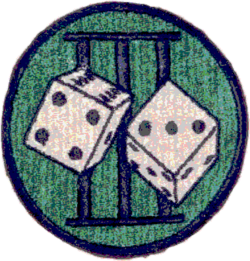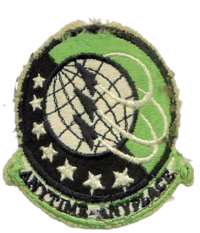307th Air Refueling Squadron
This article includes a list of references, related reading, or external links, but its sources remain unclear because it lacks inline citations. (December 2012) |
| 307th Air Refueling Squadron | |
|---|---|
 Emblem of the 306th Air Refueling Squadron | |
| Active | 1950-1990 |
| Country | United States |
| Branch | United States Air Force |
| Type | Air Refueling |
| Role | Aerial Refueling |

The 307th Air Refueling Squadron is an inactive United States Air Force unit. It was last assigned to the 410th Bombardment Wing, stationed at K.I. Sawyer AFB, Michigan. It was inactivated on 1 August 1990.
History
The 307th ARS was first activated in June 1950 and attached to the 307th Bombardment Wing at MacDill Air Force Base, Florida. The unit, however, was located at Davis-Monthan AFB, Arizona for flying. The 307th gained its crews and equipment from the inactivated 2d Air Refueling Squadron (which later started up again at Hunter AFB, Georgia). 307th crews flew the KB-29M Superfortress, a British grappling hose-type refueling aircraft. On 1 Aug 1951, the people and equipment inactivated and stayed at Davis-Monthan to form the 9th Air Refueling Squadron.
In August 1951, upon relocating to Walker Air Force Base, New Mexico, the 307th refueled other aircraft by using the KB-29P Superfortress, a boom type refueling system developed by Boeing. It was at Walker that the squadron performed the first U.S. Air Force over-water fighter refueling mission. Many people assigned to the squadron during this time participated in Project Ivy, the atomic tests in the Pacific.
After relocating to Bergstrom Air Force Base, Texas, the unit performed refueling missions for the 27th Fighter-Escort Wing F-84 Thunderjet aircraft within the 42d Air Division. However, when everyone but one officer and one airman were reassigned, the squadron was inactivated on 18 November 1953.
Just six months later, the unit was reactivated and flew out of Maxwell Air Force Base, Alabama, with KC-97 Stratotanker aircraft. Another six months later, after being a tenant unit, the squadron was happy to move to Lincoln Air Force Base, Nebraska, and rejoin the 307th Bombardment Wing. From 1955 to 1960 the 307th deployed to numerous bases outside the United States, providing tanker support for Strategic Air Command (SAC) forces.
In June 1960 the unit moved once again to Selfridge Air Force Base, Michigan. After performing, for ten years, refueling commitments on a global scale, the squadron was inactivated on 25 June 1966. On 30 September 1985, the 307th was reactivated at a formal ceremony at K.I. Sawyer Air Force Base, Michigan. The squadron, assigned to the 410th Bombardment Wing at Sawyer, was flying for the first time, the KC-135A Stratotanker. The unit inactivated on 1 August 1990.
Lineage
- Constituted as the 307th Air Refueling Squadron, Medium and activated on 16 June 1950
- Inactivated on 18 Nov 1953
- Reactivated on 8 Nov 1954
- Discontinued and inactivated 25 Jun 1966
- Reactivated as the 307th Air Refueling Squadron on 30 Sep 1985
- Inactivated on 1 Aug 1990
Assignments
- 307th Bombardment Wing, 16 June 1950 – 16 Sep 1950
- 43d Bombardment Wing, 16 Sep 1950 – 1 Aug 1951
- 47th Air Division, 1 Aug 1951 – 1 Jul 1953
- Attached to 6th Bombardment Wing, 1 Aug 1951 – 15 Jun 1952
- 42d Air Division, 1 Jul 1953 – 18 Nov 1953
- 307th Bombardment Wing, 8 Nov 1954 – 1 Jun 1960
- 4045th Air Refueling Wing, 1 Jun 1960 – 1 Jan 1963
- 500th Air Refueling Wing, 15 Dec 1964 – 25 Jun 1966
- 410th Bombardment Wing, 30 Sep 1985 – 1 Aug 1990
Stations
- MacDill AFB, Florida, 16 June 1950 – 16 Sep 1950
- Davis-Monthan AFB, Arizona, 16 Sep 1950 – 1 Aug 1951
- Walker AFB, New Mexico, 1 Aug 1951 – 1 Jul 1953
- Bergstrom AFB, Texas, 1 Jul 1953 – 18 Nov 1953
- Maxwell AFB, Alabama, 18 May 1954 – 8 Nov 1954
- Lincoln AFB, Nebraska, 8 Nov 1954 – 1 Jun 1960
- Selfridge AFB, Michigan, 1 Jun 1960 – 25 Jun 1966
- K.I. Sawyer AFB, Michigan, 30 Sep 1985 – 1 Aug 1990
Aircraft
- KB-29M Superfortess, 1950-1951
- KB-29P Superfortress, 1951-1953
- KC-97G Stratotanker, 1954-1966
- KC-135A Stratotanker, 1985-1990
References
![]() This article incorporates public domain material from the Air Force Historical Research Agency
This article incorporates public domain material from the Air Force Historical Research Agency


